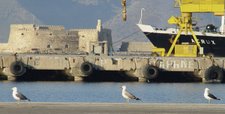
Rain during the night, north winds - best case of gulling in Herakleion Harbour!
Although late March there are still wintering birds around. At least 15 individuals of the LBBG complex, including the late staying ringed Baltic one, one or two Heuglin's. Also one 2 cal-y Caspian, and several YLG, two Sandwich Terns and one difficult bird as usual!. The strong wind make photography difficult but I try my best!
The well known male Baltic in summer plumage now!:

From left side one Heuglini (lagre with one white mirror on P10, one intermedius type with large white mirror, one LBBG with still wintering plumage, probably subadult, the ringed Baltic and a YLG:

Close view of the two of the previous birds:

And the "suvadult" LLBB again, maybe a female Heuglin's? :

Two more intermedius type adult birds with larhe white mirrors in both R10-P9:


And another LBBG, beside of the YLG with only a small mirror, different bird than previous with long wings and lighter. Probably another Heuglin's? :

The wind plays with the plumage of this presumed as 2nd cal year Baltic Gull:


Caspian I suppose:


And YLG:

Trying to understand the moulting differences between 1st summer Caspian and YLG:

And finally the difficult one! :

From far away was looking as a big Common Gull. Grey/fleshy legs are also remind Common or LBBG cases. The small dark eye reminds a Caspian but look the dark mantle comparing to YLG. Bill too slender for an Armenian Gull. The clean white head with only few streaks, mainly on hindneck looks strange for western LBBG cases in Mar although can be an advanced one. Moult like a Heuglin's but the bird is smaller than a candidate female of that taxon, the head is rounded and the bill is rather slender. So what?

 Places for interest for Gulling are the harbour, the Almyros wetland to the west and the waste tratment site further west. From NHMC there are easy paths to the west (Giofyros river mouth) and to harbour to the east. (next picture). During late November most wintering gulls are present including the common Yellow-legged and Black-headed, also Mediterranean, Caspian, Baltic, Lesser Black-backed, Heuglin's are easy and in most cases Armenian, Slender-billed, Little and Audouini's gulls are present. Pallas Gull is a vagrant with good chance to be present too, other taxa/forms are either vagrants or still unconfirmed for the site.
Places for interest for Gulling are the harbour, the Almyros wetland to the west and the waste tratment site further west. From NHMC there are easy paths to the west (Giofyros river mouth) and to harbour to the east. (next picture). During late November most wintering gulls are present including the common Yellow-legged and Black-headed, also Mediterranean, Caspian, Baltic, Lesser Black-backed, Heuglin's are easy and in most cases Armenian, Slender-billed, Little and Audouini's gulls are present. Pallas Gull is a vagrant with good chance to be present too, other taxa/forms are either vagrants or still unconfirmed for the site. A map of the town with some hotels here:
A map of the town with some hotels here: More information about the Program of the meeting and important dates will be post next month.
More information about the Program of the meeting and important dates will be post next month.


























































